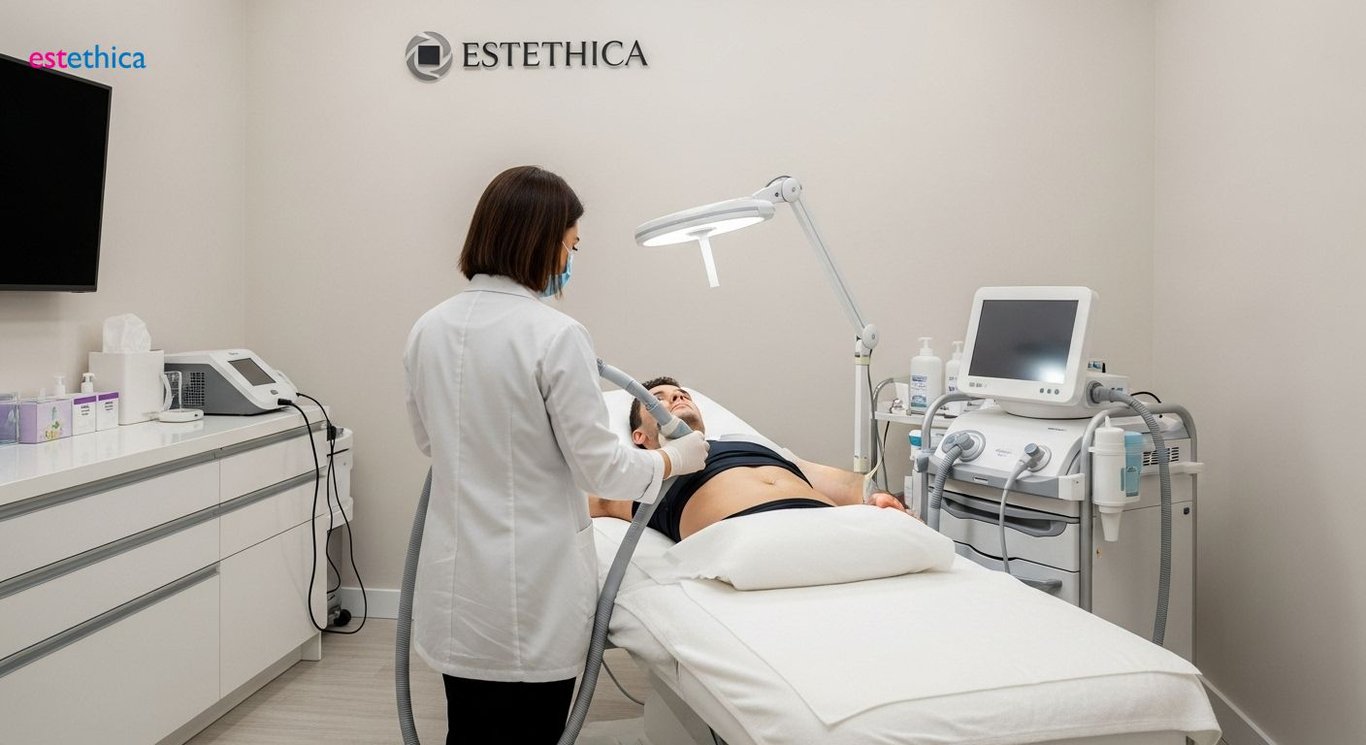Gynecomastia: Beyond Enlarged Male Breasts - Solutions Explored
Discover solutions to gynecomastia, enhance male health, and boost confidence through informed choices.
Gynecomastia, a condition characterized by the enlargement of male breast tissue, is more than a cosmetic concern. It often signals underlying health issues that need addressing. This article explores the various solutions available and delves into the core causes, helping male individuals regain confidence and well-being.
Decoding Gynecomastia: Unveiling the Root Causes
Hormonal Shifts and Gynecomastia Development
Gynecomastia is often triggered by a hormonal imbalance, most notably an increase in estrogen or a decrease in testosterone. This imbalance disrupts the natural equilibrium, favoring the development of male breast tissue. For instance, the ratio of estrogen to testosterone influences breast tissue growth, and any shift in this balance can lead to gynecomastia. Such hormonal fluctuations can occur due to various factors, including puberty, certain medications, and underlying health conditions.
The onset of gynecomastia can also be influenced by external factors such as substance abuse or specific medical treatments. Anabolic steroids, for example, can disrupt hormonal balance, leading to the development of enlarged male breasts. Certain medications used to treat conditions like prostate cancer or high blood pressure can also have similar effects. Identifying these potential triggers is vital for managing and addressing the condition effectively.
Factors Contributing to Hormonal Imbalance
- Medications: Certain drugs, like anti-androgens and steroids, can disrupt hormone balance, leading to gynecomastia.
- Health Conditions: Liver or kidney disease can affect hormone metabolism, triggering gynecomastia by altering the estrogen-testosterone ratio.
- Substance Abuse: Alcohol and drug use can interfere with hormone production, contributing to hormonal imbalances and the development of gynecomastia.
Lifestyle changes are often recommended to manage enlarged male breasts. A balanced diet and regular exercise can help regulate hormone levels and reduce fat tissue, which can exacerbate the condition. In some cases, medical interventions like hormone therapy or surgery may be necessary to correct the underlying hormonal imbalance and reduce breast tissue.

Male Breast Reduction: Surgical and Non-Surgical Options
Surgical Options for Gynecomastia Correction
For individuals experiencing significant emotional or physical discomfort due to gynecomastia, male breast reduction offers a direct, effective solution. Surgical options include liposuction, particularly effective when the enlargement arises from excess fatty tissue. Liposuction involves the removal of fat through small incisions, resulting in minimal scarring. For example, patients with mild to moderate gynecomastia often find liposuction to be a suitable and less invasive option. estethica offers advanced liposuction techniques tailored to individual patient needs, ensuring optimal aesthetic outcomes.
For cases involving excessive glandular tissue, a mastectomy might be necessary, employing more invasive techniques to remove breast tissue completely. This procedure typically involves excising both the glandular tissue and excess skin to reshape the chest. estethica's surgeons are skilled in performing mastectomies with a focus on minimizing scars and achieving a natural-looking chest contour. For instance, men with significant glandular enlargement may benefit from a mastectomy to achieve the desired aesthetic result.
Non-Surgical Approaches to Managing Enlarged Male Breasts
- Hormone Treatments: Medications like selective estrogen receptor modulators (SERMs) can help balance hormone levels, potentially reducing breast tissue.
- Targeted Exercise Regimens: Implementing chest workouts can enhance muscle tone and diminish the appearance of chest fat.
- Dietary Adjustments: Reducing the intake of processed foods and increasing protein consumption can aid in decreasing overall body fat, thus impacting chest fat levels.

Pseudogynecomastia vs. True Gynecomastia: Accurate Diagnosis
Diagnostic Methods for Differentiating Gynecomastia Types
Accurate diagnosis is essential in distinguishing between pseudogynecomastia and true gynecomastia. While the latter involves actual glandular tissue enlargement, pseudogynecomastia is primarily caused by fat deposits. Diagnosis typically involves a thorough physical examination to assess the texture and composition of the breast tissue. For instance, a doctor will palpate the area to determine if the enlargement is due to firm glandular tissue (true gynecomastia) or soft, fatty tissue (pseudogynecomastia). Additionally, assessing the patient's medical history, including medication use and hormonal conditions, is crucial for an accurate diagnosis.
To further refine the diagnosis, blood tests may be conducted to evaluate hormone levels. These tests measure the levels of testosterone, estrogen, and other hormones that can influence breast tissue development. Abnormal hormone levels can indicate an underlying cause of gynecomastia, such as hormonal imbalance in men caused by hypogonadism or hyperthyroidism. estethica specialists use advanced diagnostic tools to ensure precise differentiation, guiding effective treatment strategies tailored to individual patient needs. For example, an endocrinologist might be consulted to assess and manage hormonal imbalances contributing to gynecomastia.
Importance of Distinguishing Between Gynecomastia and Pseudogynecomastia
- Treatment Planning: Correct diagnosis guides effective treatment strategies, ensuring individuals receive appropriate care, whether surgical or non-surgical.
- Avoiding Unnecessary Procedures: Accurate differentiation prevents patients with pseudogynecomastia from undergoing unnecessary glandular tissue removal.
- Personalized Care: Tailoring treatment to the specific condition—whether it's reducing fat deposits or addressing hormonal imbalances—leads to better outcomes.
A correct diagnosis is pivotal in guiding effective treatment strategies, ensuring individuals receive appropriate care, whether surgical or non-surgical. For example, if pseudogynecomastia is diagnosed, lifestyle adjustments such as diet and exercise may be recommended to reduce overall body fat. In contrast, true gynecomastia might require medical interventions like hormone therapy or surgical excision of glandular tissue. At estethica, a precise diagnosis ensures each patient receives a treatment plan that aligns with their specific condition and goals. This individualized approach enhances satisfaction and achieves optimal results.

Gynecomastia and Hormonal Imbalance: Restoring Male Harmony
Hormonal Therapy for Gynecomastia
Men experiencing gynecomastia often face a disruption in hormonal balance, notably excess estrogen. Treatment protocols often include hormonal therapy to stabilize testosterone levels, potentially shrinking the enlarged breast tissue. Regular monitoring and adjustments to treatment plans are crucial for restoring balance and maintaining health. For example, anti-estrogen medications can block the effects of estrogen, helping to reduce breast size. Furthermore, testosterone replacement therapy may be used in cases where low testosterone levels contribute to the imbalance. estethica specialists provide tailored hormonal treatments to address the specific needs of each patient, focusing on achieving optimal hormonal balance and reducing gynecomastia symptoms.
Besides medical interventions, adopting lifestyle changes such as reducing alcohol and drug use, incorporating regular exercise, and maintaining a healthy diet can support hormonal health and thus curb the symptoms of gynecomastia. For instance, reducing alcohol consumption can improve liver function, which plays a key role in hormone metabolism. Regular exercise helps maintain a healthy weight, reducing the risk of excess fat tissue that can exacerbate gynecomastia. A balanced diet rich in fruits, vegetables, and lean proteins supports overall hormonal health and reduces the likelihood of further imbalances. Combining these lifestyle adjustments with medical treatments can effectively manage and reduce enlarged male breasts.
Lifestyle Adjustments for Hormonal Health
- Dietary Changes: Adopt a balanced diet rich in lean proteins, fruits, and vegetables to support hormonal balance.
- Regular Exercise: Incorporate physical activity to maintain a healthy weight and reduce excess fat tissue.
- Reduce Substance Use: Limit alcohol and avoid recreational drugs to prevent hormonal disruptions.
Effective management of hormonal imbalances through lifestyle adjustments is crucial in addressing gynecomastia. For example, incorporating strength training exercises can help build chest muscle, improving the overall appearance of the chest. Avoiding processed foods and sugary drinks can prevent spikes in estrogen levels. Prioritizing sleep also plays a significant role, as it supports healthy hormone production. estethica emphasizes these holistic approaches, recommending lifestyle modifications alongside medical treatments to achieve comprehensive results. Such an integrated approach leads to improved patient satisfaction and long-term well-being.
Additional Strategies for Maintaining Hormonal Balance
- Stress management: Techniques like meditation and yoga, which lower cortisol levels and balance hormones.
- Regular check-ups: Routine medical evaluations to monitor hormone levels and detect potential imbalances early.
- Avoid endocrine disruptors: Limiting exposure to chemicals like BPA found in plastics.
Understanding Gynecomastia: Causes, Symptoms, and Treatments
Slim Lipo for Enhanced Gynecomastia Treatment: Precision Fat Removal and Skin Tightening
Comprehensive Diagnostic and Treatment Plans for Accurate Gynecomastia Management
Frequently Asked Questions
What is gynecomastia and what are its primary causes?
How is true gynecomastia differentiated from pseudogynecomastia?
What surgical and non-surgical options are available for male breast reduction?
How can hormonal imbalances be addressed to restore male harmony and reduce gynecomastia?
What lifestyle changes can help manage gynecomastia and support hormonal health?
Achieve your aesthetic goals with estethica's world-class expertise, book your free consultation today.
📞 Call Now for a Free Consultation!